The Tsitsikamma National Park on the Garden Route is one of South Africa’s top attractions. What awaits you here? Fresh sea air, lush green jungle, beautiful hiking trails, rugged cliffs, crashing waves, beaches, the turquoise ocean, and much more—welcome to the Tsitsikamma National Park.
Our round trip through South Africa took us from Jeffreys Bay and the Addo Elephant Park to the Tsitsikamma National Park in South Africa. By this point, we had already covered more than 1,700 kilometers. A beautiful landscape awaited us. Today we’ll tell you all the highlights, tips and hikes in this beautiful region.
What else you should know
- Best time to travel to South Africa
- Currency of South Africa
- South Africa Entry & Visa
- Round trip with a rental carcarcar
- Travel insurance
- Garden Route South Africa
- Krüger National Park
- Panorama Route South Africa
- The beautiful Winelands
- Safety in South Africa
- What else you should know
- 1. Getting to the National Park
- 2. Prices and Opening Hours
- 3. Best Time to Visit Tsitsikamma National Park
- 4. Shopping & Restaurants
- 5. Accommodation in and around Tsitsikamma Park
- 6. Other Activities in the Park
- 7. Hikes in the National Park
- 8. The Waterfall Trail
- 9. Multi-Day Hike
- 10. Beach & Swimming
- 11. Bungee Jumping
- Frequently Asked Questions about Tsitsikamma National Park
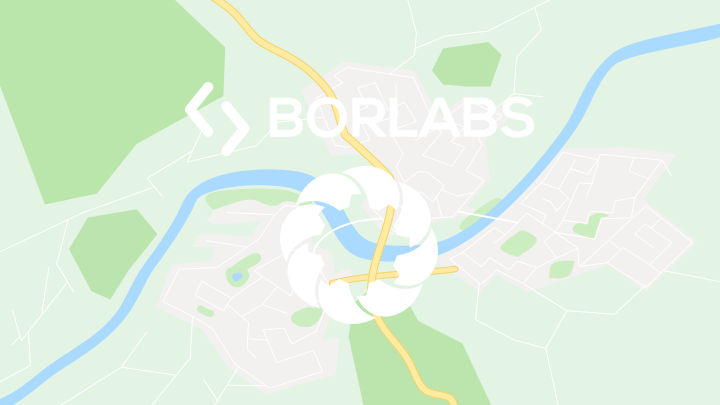
By loading the map, you accept Google’s privacy policy.
Learn more
Load map
1. Getting to the National Park
Tsitsikamma National Park is located along the Garden Route between Jeffreys Bay and Knysna, at the mouth of the Storms River. This beautiful national park is located directly on the N2 and is therefore easily accessible by rental car. If you’re starting from Cape Town, you should plan at least 2 days.
From Cape Town, it’s 580 kilometers (approx. 6 hours drive). From Port Elizabeth, it’s only 180 kilometers on the N2. You should plan at least 3 hours for this. There are parking spaces on site, but depending on the time of day (and travel time), they can quickly fill up. We recommend visiting the park early in the morning or later in the afternoon.

You can also reach this region with the BazBus. Unfortunately, the bus only stops in Storms River. From there, we recommend taking an Uber; more adventurous travelers can try hitchhiking in the relatively safe area. The BazBus travels across the country between Cape Town, Port Elizabeth, Durban, and Johannesburg. We haven’t had any experience with this bus ourselves, but we think it’s a great option. However, our e-book, in collaboration with BasBuz, contains a detailed chapter on this.
2. Prices and Opening Hours
- Address: XVQ9+HJ Stormsrivier, South Africa
- Opening Hours: Depending on the season (exact times here)
- Entrance Fees: Adults R296 (approx. €15), Children R148 (approx. €7)
3. Best Time to Visit Tsitsikamma National Park
You can basically visit South Africa year-round. However, there are differences between the various regions within the country. The climate in this region is very mild year-round, with temperatures between 25 and 28°C in the South African summer (December to March).
In the low season (April to November), temperatures here are a pleasant 21 to 22°C. You can expect rain at any time in this region. However, the least precipitation occurs between May and August. You can find out more about the climate in South Africa here: Best time to visit South Africa.
4. Shopping & Restaurants
Would you like to eat or do some shopping while you’re there? In the area, you’ll find a few gas stations with snack options, as well as restaurants and cafés. The “Tsitsikamma Restaurant” is located directly in the national park on the way to the bridge. Here you can get typical dishes such as fries, fish, meat, seafood, and more.
At the “Cattle Baron Tsitsikamma” you can also get hot meals, which are a bit more expensive than at the Tsitsikamma Restaurant. At “The Parks Shop” you can buy some souvenirs. There are also restrooms and camping facilities in the area.
In the small town of Stormsrivier, you’ll find accommodations, restaurants, and a supermarket. However, the selection is better in a larger town like Plettenberg Bay. Here, you’ll find well-known supermarket chains (Checkers, Superspar, Picknpay, Kwikspar, and others) and can shop conveniently.
Plettenberg Bay is about 60 kilometers from Tsitsikamma National Park, so it’s best to shop in advance.
5. Accommodations in and around Tsitsikamma Park
We didn’t stay directly in Tsitsikamma National Park, but in Nature’s Valley. And what can we tell you? At the end of the day, we ended up in a safari tent at Rocky Road Backpackers (permanently closed!). The tent had a large double bed with electric blankets and a bedside table with a lamp. Honestly, it was more than we expected and an absolutely fantastic experience!
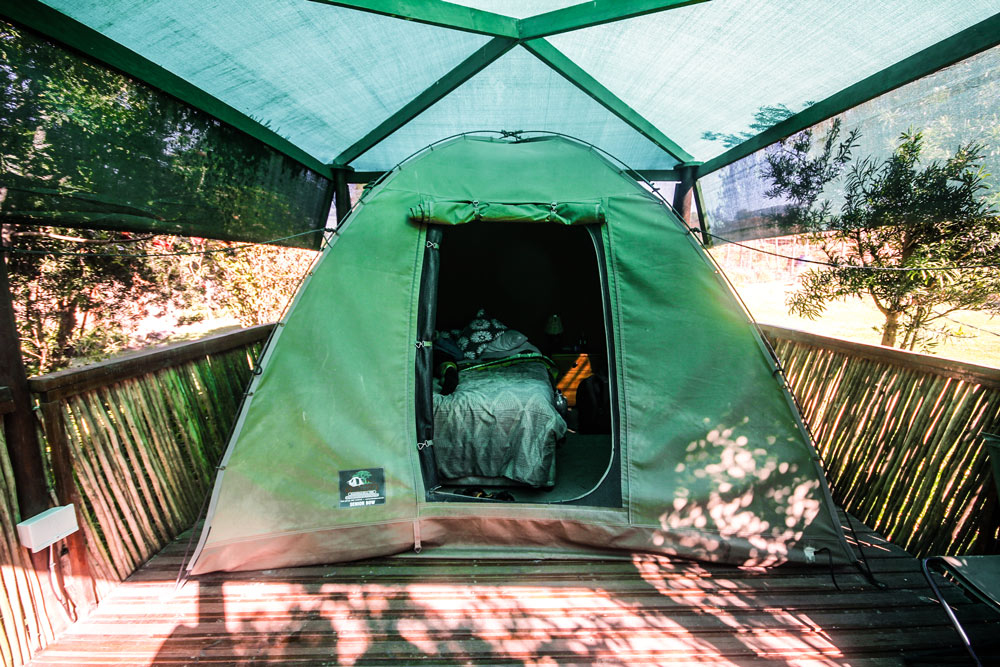
The complex is only about 20 minutes from the Bloukrans Bridge. We arrived and immediately thought: WOW! What a beautiful place to stay. The area was huge, quiet, and completely isolated from the rest of the world. It was just incredibly cozy there.
And so, within the first 30 minutes, we decided that we wanted to stay for two nights. Said! Done! We immediately extended our stay, signed up for the bungee jump, and enjoyed our time with Rocky to the fullest. Time truly disappears here!
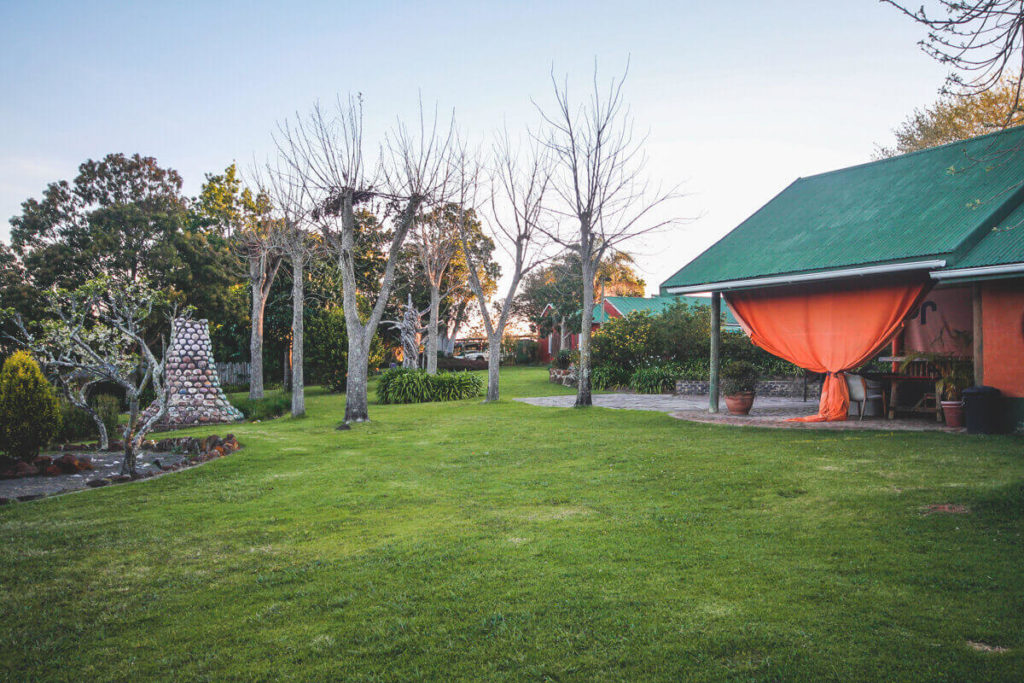
You can also stay overnight within the Tsitsikamma Park. There are wooden huts with great views, or you can sleep in your own tent or camper. We saw the huts on site, and they also made a really good impression. However, you should book early, as the huts and pitches are naturally very popular. You can find further information on costs and local options here.
Other accommodations in the area:
- Mountain Breeze Log Cabins*
- Imka Trinity Retreat*
- Pear Tree Cottage*
- Tsitsikamma Village Inn*
- The Fernery Lodge & Chalets*
6. Other activities in the park
There are plenty of adventures to experience in the Tsitsikamma National Park in South Africa. We have selected and noted the most popular tours for you. Do you know of another cool tour in the Tsitsikamma Park that isn’t listed here? Let us know.
You can’t go on a classic safari in the park, like in Addo Elephant Park or Krüger National Park. There are numerous animals in the park, but you’ll encounter some of them more by chance or not at all. We just wanted to mention this here, as it’s been asked about several times.
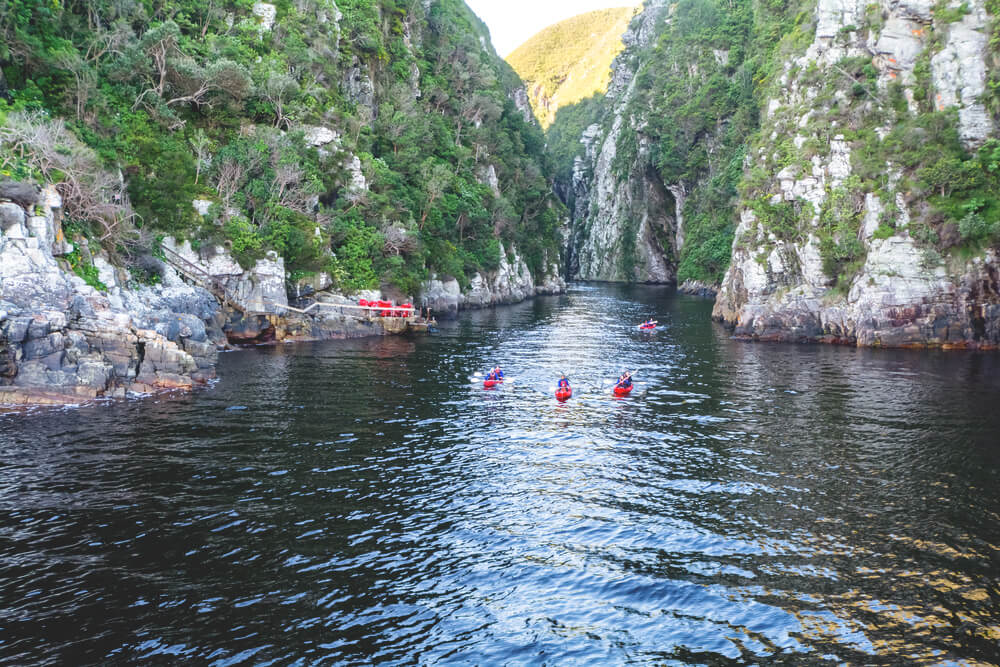
7. Hikes in the National Park
There are many different hiking trails in the area. We hiked the Waterfall Trail and the Mouth Trail to the suspension bridge. The Mouth Trail is the easiest hiking trail in the park and is only about a kilometer long and runs along a wooden boardwalk. You should plan on about half an hour for this hike (the round trip can be done comfortably in an hour). At the end of the trail, a few steps lead down to the Suspension Bridge.
You should definitely walk across the 77-meter-long suspension bridge. This bridge runs over the Storms River Mouth. On the sides, you can see the steep, impressive rock walls. Small boats depart from near the Suspension Bridge for a short trip into the Storms River Gorge. The ride is beautiful and gives a good impression of the gorges along the Garden Route, but it’s not exactly cheap.
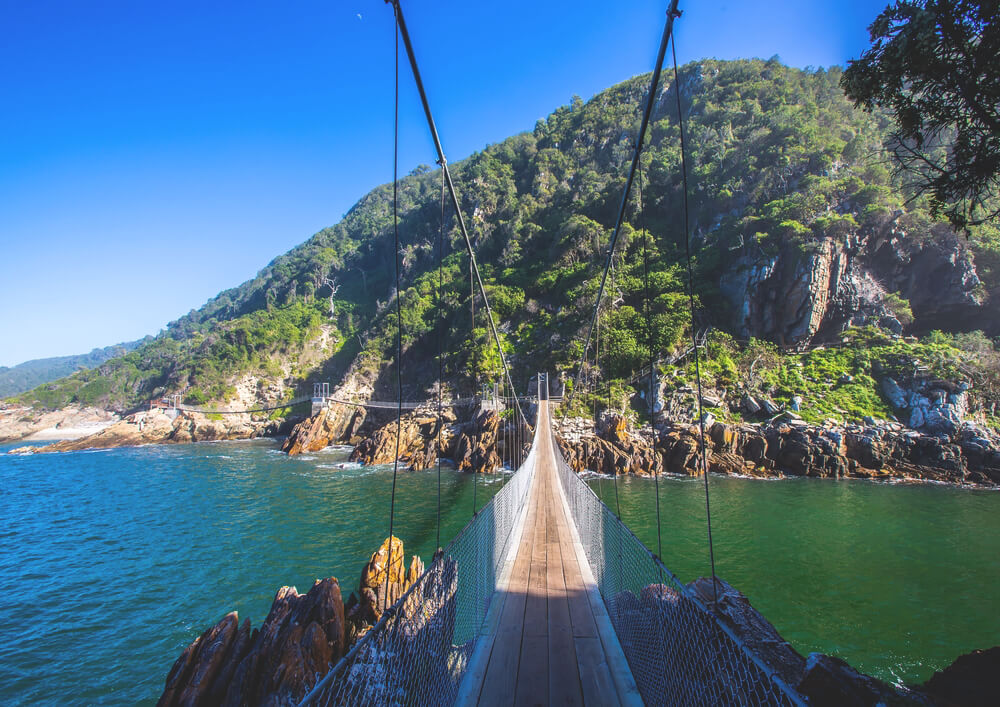
Look-Out Trail & Mouth Trail
If you have a little more time, you can continue directly after the Mouth Trail to the Lookout Trail. This leads you up the mountain on the other side of the bridge to a wonderful viewpoint. Since you have to hike up the mountain, the walk takes a bit longer. But even the way up promises great views. You should plan at least 2 hours or more for the entire route (Mouth Trail and Lookout Trail).
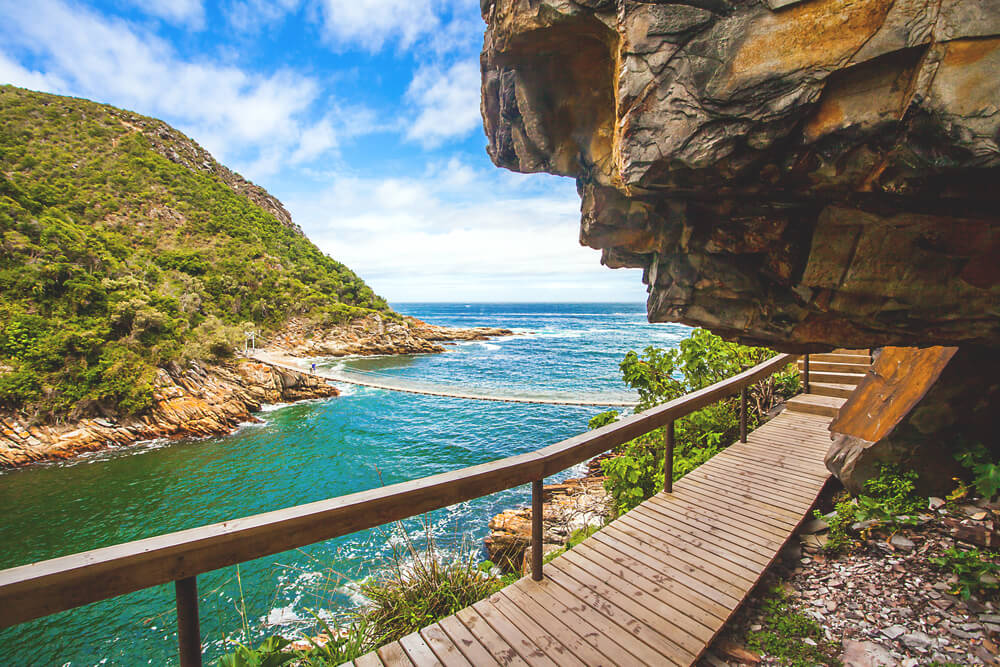
If you have more time, the Blue Duiker Trail could be perfect for you. It leads through the interior and takes you to the Agulhas Lookout Point. Whales and dolphins are often seen here. The trail is just under 3.7 kilometers long and starts at Lookout Point. Other day hikes include the Loerie Trail and the Waterfall Trail. You can find all the information and hikes here: Sanparks.org.
8. The Waterfall Trail
We completed the Waterfall Trail. This trail marks the start of the Otter Trail and ends at the Tweeriviere River, which drops 50 meters and is collected in a large, natural pool. You should wear sturdy shoes, as half of the route involves climbing over the many rocks along the coast. The round trip took us just under 2.5 hours.
In general, the trail is quite easy to do. A sign states that you shouldn’t start after 5 p.m. In South Africa, it gets dark very early, especially in spring, autumn, and winter. And walking this trail in the dark? Better not! You can’t see anything anymore anyway!
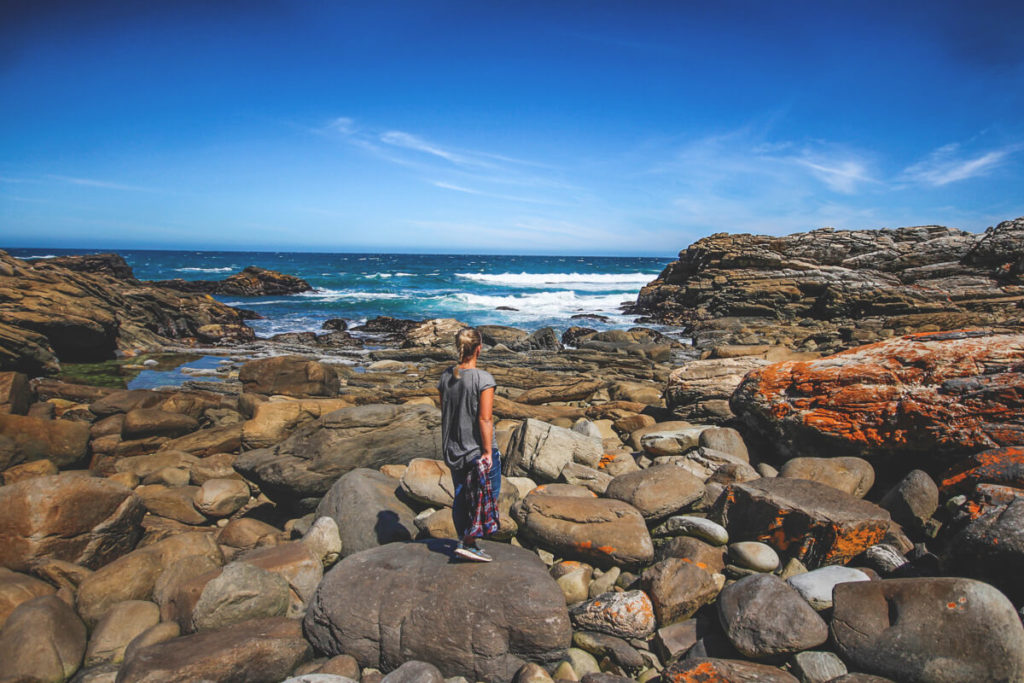
Breathtaking views of the sea
The scenery simply blew us away. Again and again we stopped, sat down, or turned around. It couldn’t be real! Those colors! It was simply overwhelming. Add to that the weather, a good mood, and his favorite person by his side—what could be better? Marco had a lot of fun jumping from rock to rock anyway. He absolutely loves that sort of thing—the main thing is action and movement. Boys, that’s it!

We continued walking over the rocks until we entered the forest again. After about 1.5 hours, we reached the waterfall. Here, the water trickled into the depths. The wind made you feel a light drizzle of water on your skin – like a kind of humidifier.
We sat down on the rocks and couldn’t get enough of this scenery. A photo can’t really convey how beautiful this place is in reality. Luckily, we heard about this park, otherwise we probably would never have ended up there. Anyone traveling along the Garden Route shouldn’t miss this trail.

9. Multi-day hike
You can also hike for several days in the Tsitsikamma National Park. There are the Dolphin Trail, the Otter Trail, and the Tsitsikamma Trail. The Otter Trail starts at the Storm River Mouth Camp and runs approximately 42 kilometers to Nature’s Valley. You should plan around five days for this tour. You can stay in simple huts along the way.
The hike requires some stamina and fitness. Occasionally, you’ll have to cross rivers or climb rocks. The fascinating landscapes, however, will reward your efforts. You need a permit for this trail. Be prepared for long waits, as this trail is very popular and only a few people are allowed per day (€70 for the hike, including overnight stays in hiking huts).
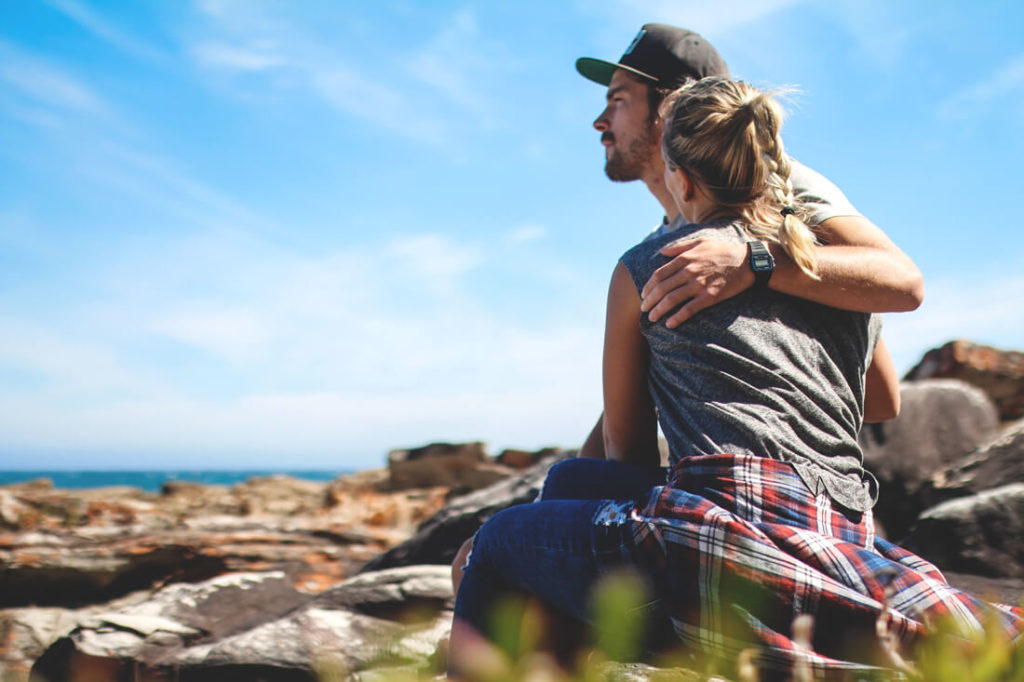
Otter Trail, Tsitsikamma Trail & Dolphin Trail
The Tsitsikamma Trail starts at the Groot River Campsite in Nature’s Valley and runs for almost 72 kilometers to Total Village, Storms River Village, or Storms Rover Mouth Camp. The trail leads through forested areas below the mountains. It forms a circular route with the Otter Trail.
You’ll spend the night in the hikers’ huts again and divide your trail into several daily stages. Cost: €10 per day and night in a hut. You can also hike the 17-kilometer Dolphin Trail. This hike only takes two days, making it the shortest of the multi-day trips. This trail is said to be very expensive due to the exclusive and expensive accommodations (approximately €370 per person): Source: sanparks.org.
10. Beach & Swimming
There are no official beaches in the national park itself where you can swim. Instead, a detour to Nature’s Valley is recommended. Here you can unwind on the idyllic beach and take relaxing walks. You can easily and relaxedly swim and splash around in the protected lagoon just off the coast.
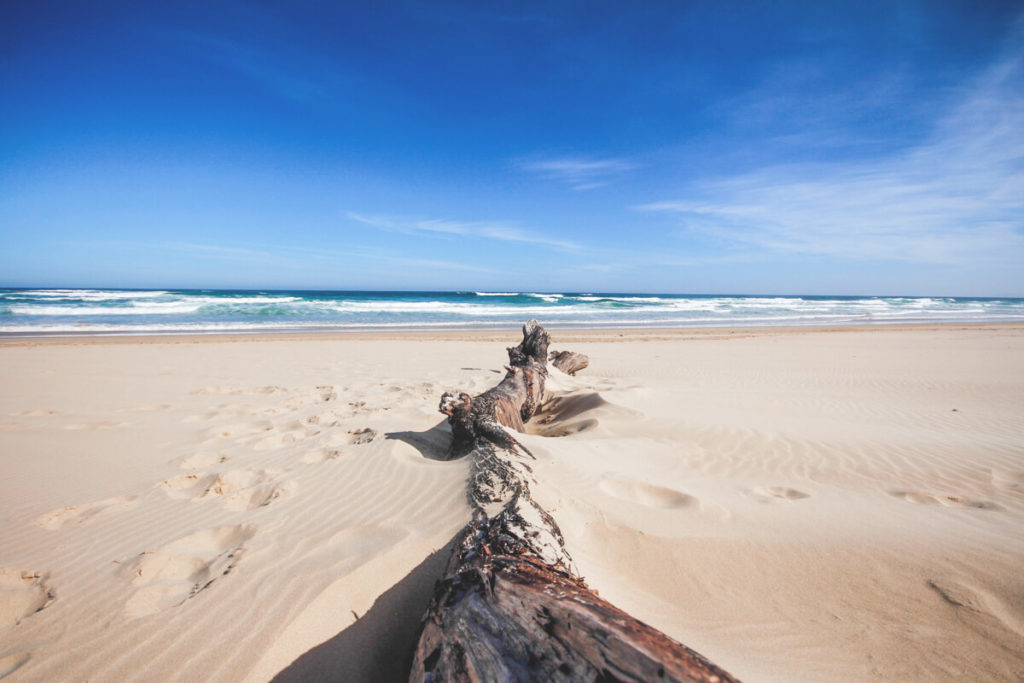
11. Bungee Jumping
We had actually arranged accommodation in Knysna over the phone. But things changed along the way. After we finished the trail in Tsitsikamma National Park, we drove to Bloukrans Bridge. This is where the world’s highest bridge bungee jump is offered. We wanted to at least check it out. After about 20 minutes, we arrived at the scene and were amazed. This bridge was really high – SERIOUSLY! Just looking at it made us feel sick, butterflies in our stomachs.
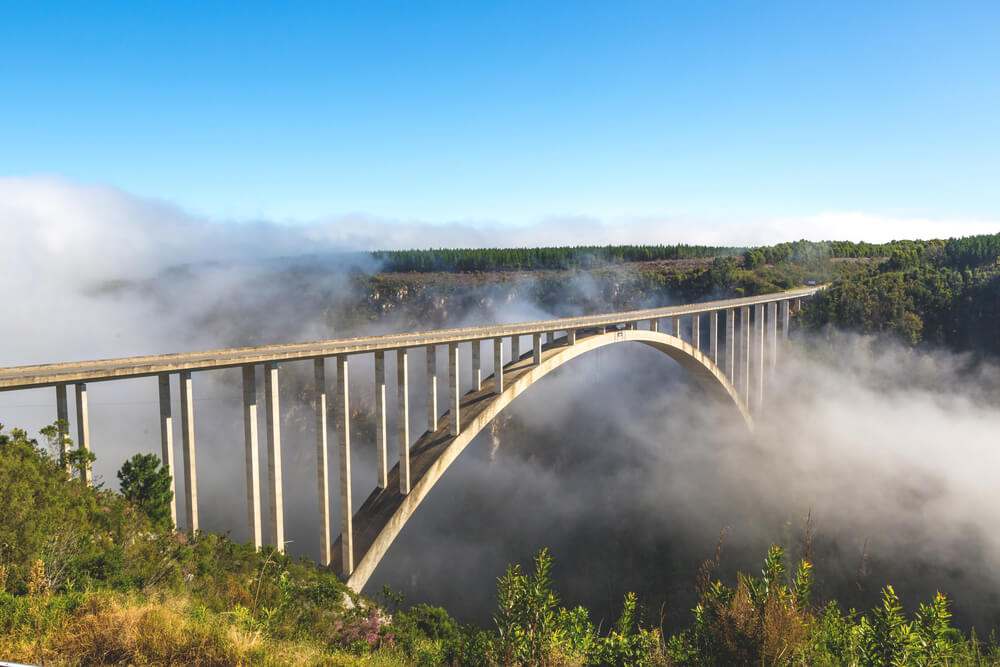
The highest bridge in Africa
At a height of almost 216 meters above the valley, this bridge is the highest in all of Africa. When you look at the crazy people who actually jump off it, you lose all faith in human reason! Who would do something like that? Why the hell would you throw yourself into the gorge? That’s almost suicidal and absolutely insane, isn’t it?
That’s exactly what I thought at first. Until I decided, “Come on, let’s just do it!” Marco wanted to do it anyway. A week before, I told him, “You go, I’m definitely not coming with you! I’m not crazy! I’ll never jump off there!” But as is often the case with both of us, Marco’s enthusiasm infected me again and again. One day later, we were back on site, and yes… we jumped! Here’s the crazy video.
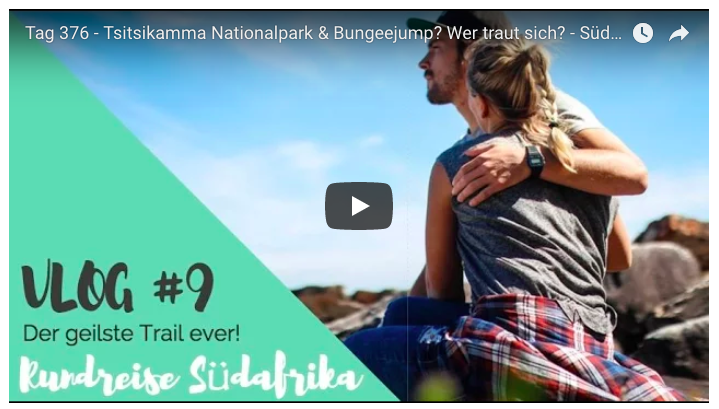
Frequently Asked Questions about Tsitsikamma National Park
Is Tsitsikamma National Park worth it? How much does the entrance fee cost? Is the park malaria-free? How much time should I allow? Can I stay overnight in the park? Is there parking in Tsitsikamma National Park?